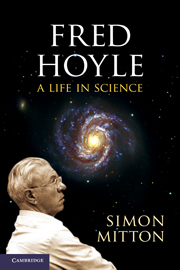Book contents
- Frontmatter
- Contents
- FOREWORD
- PROLOGUE
- 1 AN END AND A BEGINNING
- 2 TRAINING FOR COSMOLOGY
- 3 THE STAR MAKERS
- 4 HOYLE'S SECRET WAR
- 5 THE NATURE OF THE UNIVERSE
- 6 LIVES OF THE STARS
- 7 CLASH OF TITANS
- 8 ORIGIN OF THE CHEMICAL ELEMENTS
- 9 MATTERS OF GRAVITY
- 10 MOUNTAINS TO CLIMB
- 11 THE WATERSHED
- 12 STONES, BONES, BUGS AND ACCIDENTS
- ACKNOWLEDGEMENTS
- NOTES
- BIBLIOGRAPHY
- INDEX
- Plate Section
1 - AN END AND A BEGINNING
Published online by Cambridge University Press: 03 May 2011
- Frontmatter
- Contents
- FOREWORD
- PROLOGUE
- 1 AN END AND A BEGINNING
- 2 TRAINING FOR COSMOLOGY
- 3 THE STAR MAKERS
- 4 HOYLE'S SECRET WAR
- 5 THE NATURE OF THE UNIVERSE
- 6 LIVES OF THE STARS
- 7 CLASH OF TITANS
- 8 ORIGIN OF THE CHEMICAL ELEMENTS
- 9 MATTERS OF GRAVITY
- 10 MOUNTAINS TO CLIMB
- 11 THE WATERSHED
- 12 STONES, BONES, BUGS AND ACCIDENTS
- ACKNOWLEDGEMENTS
- NOTES
- BIBLIOGRAPHY
- INDEX
- Plate Section
Summary
On 19 august 1972, Fred Hoyle sat in his office at the Institute of Astronomy in Cambridge for the last time. His summer had been busy. A record number of academic visitors had come to the institute to benefit from summer conferences, collaborations, lectures and discussions. He had fretted to make sure the institute would be financed securely for the next five years. Just three weeks earlier, the Institute of Astronomy had been born through a merger of two astronomy departments, after the university had decided to join the historic Observatories established in 1823 with the pioneering Institute of Theoretical Astronomy founded by Hoyle in 1965. Hoyle had been the head of Theoretical Astronomy for seven years, but now he had a new boss, because the university had not chosen him as the director of the combined institute.
On a sultry afternoon with a threat of thunder in the air, staff members who were in the old Observatories, including myself, made the short walk along the path through the parklike grounds to the building that had been the Institute of Theoretical Astronomy – IoTA for short – to take their afternoon tea in the library. This wonderful Cambridge tradition gave the researchers and their students an opportunity to exchange ideas, and maybe wish a departing visitor a safe trip back to California or India. But this afternoon, Hoyle would not be joining his colleagues for tea.
- Type
- Chapter
- Information
- Fred HoyleA Life in Science, pp. 7 - 30Publisher: Cambridge University PressPrint publication year: 2011



